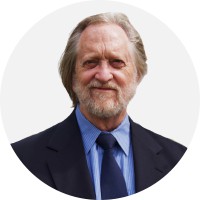The views expressed in our content reflect individual perspectives and do not represent the authoritative views of the Baha'i Faith.
The diverse and differing opinions about the essential nature – the ontology or “being” – of the prophets of God is possibly the greatest source of chauvinism and conflict among the world’s religions.
For even though few can deny the fundamental efficacy of the teachings the prophets or messengers bring, it is also apparent that much of the turmoil and slaughter that characterize the narrative of human history results from contention among religions about exactly who exactly these Beings are and which among them has primacy in their successive appearances among us.
Stated simply, the manifestations or prophets of God do not become transformed from ordinary human beings to divinely-empowered Beings. As Abdu’l-Baha notes, They are distinct from birth. They pre-exist in the realm of the spirit prior to assuming a human persona, whereas ordinary humans begin during the process of conception. The points where they receive the first intimations of their revelation does not mean that they suddenly realize they are prophets, nor that they are suddenly transformed into prophets:
Briefly, the Holy Manifestations have ever been, and ever will be, Luminous Realities; no change or variation takes place in Their essence. Before declaring Their manifestation, They are silent and quiet like a sleeper, and after Their manifestation, They speak and are illuminated, like one who is awake.
In addition, though in the station of unity, they are aware of one another and are also aware of the part they play in the ongoing enlightenment and spiritualization of humankind, They are, in the station of distinction, distinctly different beings with individual souls, and not the reincarnation of the previous prophet.
Historical Influence of the Prophets
The charismatic effect of the appearances of the messengers, intermediaries, or manifestations of God is undeniable, as is the striking similarity of their trajectories.
The powers of the social and religious movements and reforms that emanate from their appearances testify to their influence on society as a whole and, in the long run, on the advancement of the world of ideas. Yet, while they live among us on Earth in a human form, they generally appear as relatively unobtrusive, meek, humble, and thoroughly kind individuals who attract a following only when they begin to articulate ideas at odds with the positions of those in power, particularly with the staunchly held views of priests, clerics, divines, and religious authorities associated with prior revelations.
This conflict quickly evokes controversy, especially in those societies governed by a theocracy or a political authority aligned with the religious institutions that remain in place from the dispensation of the previous prophet.
The end result of the appearance of virtually every manifestation of God is that these prophets are almost inevitably rejected, ridiculed, and persecuted by those contemporaries who feel threatened by their teachings. This clash occurs in an especially vehement manner when the teachings of the new manifestations seem to contradict or alter portions of the worldview held by followers of the previous revelation. Consequently, the religion that in time emerges from the appearance of a new messenger usually does not take shape until some time after the manifestation’s death.
During their earthly lives, the teachings of the manifestation are known mostly by a small cadre of dedicated and courageous individuals who themselves face persecution and, in many cases, torture, imprisonment, or martyrdom. Likewise, the intended objective of the new manifestations in bringing about social and spiritual change would seem to have failed from the point of view of those living during the lifetime of the Manifestation inasmuch as the Prophets most often depart this life while still in relative obscurity.
Why Society Rejects Its Prophets
In terms of contemporary society, the trials and imprisonments of the prophets would probably not make the front page of our local newspapers. In fact, those of us who live in relatively comfortable material circumstances would probably pay little attention to news of the imprisonment or execution of the leader of some obscure, radical religious/political sect of “trouble makers.” The crucifixion of Christ, for example, was probably little noticed by the upper middle-class Jews or Romans of the time. He would have been merely one among a number of convicted criminals crucified that day in Jerusalem.
By the early part of the seventh century – when Muhammad declared himself a messenger of God with an authority and spiritual station identical to that of Christ – Christianity had three hundred years earlier in 324 at the Council of Nicaea already decided that Christ was not a messenger or prophet of God, but God in the flesh. Therefore, Muhammad’s repeated assertion in the Qur’an about his own station being equal to that of Christ, as well as his explicit denunciation of the literalist concept of the Trinitarian doctrine, would have made it very difficult for most Christians to recognize Muhammad as fulfilling Christ’s explicit prophecies about sending a “Comforter” to pick up where he had left off. Indeed, this same attitude about Islam still abides among most Christian communities, who believe that Christ’s appearance was the unique appearance of God in human form and the climax and conclusion of religious history on planet Earth, except for the Last Judgment, which is variously interpreted among Christian followers and theologians.
Likewise, the Moslem occupation of the Holy Land gave Christendom sufficient reason to war against what they considered to be a pagan invasion of their most sacred shrines, while the Moslem soldiers, believing Muhammad to be the divine successor to Christ, felt equally justified in securing this sacred land for the new manifestation, for whom this was likewise sacred ground. And yet, while Islam spread rapidly after Muhammad’s death, it did not achieve what religious historians refer to as its “Golden Age” until the middle of the thirteenth century, more than seven hundred years after his passing.
Historically the efflorescence of a religion, the height of its moral and spiritual influence, together with its subsequent impact on human learning and social structures, does not become readily apparent until a significant period of time after the manifestation has appeared.
To a certain extent, the gradualness of that ascent might be the result of the manifestation’s choice not to contend with temporal authority nor to seek any sort of secular or popular status. Furthermore, even though the prophets bring progressive enlightenment for humankind, their teachings often challenge directly the orthodoxy of the presiding system of belief that has become entrenched among the so-called learned of the day. Thus it is only among the early followers of a new divine messenger that the renovated worldview and spiritual insights become received as liberation from past beliefs, and that the traditions and authority of the previous revelation are understood to be inadequate to describe current reality or to provide needed social and spiritual guidance.
The dramatic alteration in the worldview that occurred with the advent of Islam offers us a prime example of how this transition from one revelation to another challenges and tests humanity.
As just one example, by the time of the appearance of Muhammad, the Christian view of cosmology was importantly aligned with and dependent on the Ptolemaic geocentric theory that the Earth is the center of the universe. While the eventual acceptance of an altered view of cosmology in Christendom – the heliocentric solar system – is often attributed to the sixteenth century European Christian Renaissance scholar Nicolaus Copernicus, the heliocentric theories were initially set forth by Islamic scholars some three centuries earlier. Furthermore the European Renaissance that lifted western Christendom out of the so-called dark ages was instigated, as many scholars now readily acknowledge, by the influence and effulgence of Islamic scholarship.
These major societal advances, when properly understood and attributed, can help us gauge the real impact of the messengers of God.
















Comments
Sign in or create an account
Continue with Googleor